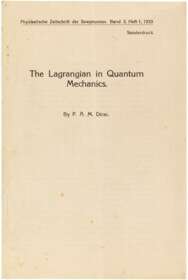ID 370007
Lot 18 | Quantum theory to ‘take over all the important parts’ of classical physics
Estimate value
£ 3 000 – 5 000
The Lagrangian in Quantum Mechanics. [Offprint from Physikalische Zeitschrift der Sowjetunion, v.3, pp.64-72]. Charkow: Technischer Staatsverlag, 1933.
Octavo (229 x 152mm); original printed wrappers (very minor spotting, light crease where once folded).
Very scarce offprint of a momentous paper. Quantum theory was now able to ‘take over all the important parts’ of classical physics. This conclusion was reached by Paul Dirac in 1933, its substance laid out in this seminal paper. It allowed Feynman to devise the path-integral formulation of quantum mechanics, and his integrals – Feynman’s own Nobel Lecture underscoring this connection. ‘In the autumn of 1932, Dirac’s research [into the development of quantum mechanics by analogy with classical mechanics] relied on two quantities. The first, known as the Lagrangian, is the difference between an object’s energy of motion and the energy it has by virtue of its location. The second, the so-called “action” associated with the object’s path, is calculated by adding the values of the Lagrangian from the beginning of the path to its end. In classical physics, the path taken by any object between two points in any specified time interval turns out... to be the one corresponding to the smallest value of the “action”... Dirac thought that the concept of “action” might be just as important in the quantum world of electrons and atomic nuclei as it is in the large-scale domain. When he generalised the idea to quantum mechanics, he found that a quantum particle has not just one path available to it but an infinite number, and they are – loosely speaking – centred around the path predicted by classical mechanics. He also found a way of taking into account all the paths available to the particle to calculate the probability that the quantum particle moves from one place to another... Dirac was quietly pleased with his "little paper" and wrote in early November to one of his colleagues in Russia: "It appears that all the important things in the classical [...] treatment can be taken over, perhaps in a rather disguised form, into the quantum theory"’ (G. Farmelo, The strangest man, 1988,pp. 215-6). The journal Physikalische Zeitschrift der Sowjetunion is very uncommon both institutionally and on the market. Offprints are exceptionally rare.
| Address of auction |
CHRISTIE'S 8 King Street, St. James's SW1Y 6QT London United Kingdom | |
|---|---|---|
| Preview |
| |
| Phone | +44 (0)20 7839 9060 | |
| Buyer Premium | see on Website | |
| Conditions of purchase | Conditions of purchase |



